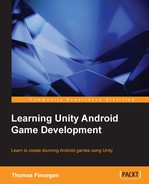Book Description
Learn to create stunning Android games using Unity
In Detail
Unity 5 is a revolution in developing great games for Android that provides a great integration platform that works seamlessly with Unity 5, which means that games can be developed quicker and easier than ever before.
Packed with a lot of examples, this book starts by helping you to understand all the great features that Unity 5 and Android have to offer. You will then create great games like Tic-Tac-Toe and the Monkey Ball game and also learn to enhance them. You will then expand the game's environment with lights and a skybox and learn to create enemies in a tank battle game. You will then explore the touch and tilt controls with the creation of a Monkey Ball clone.
With the recreation of a game similar to Angry Birds, you will delve into configuring physics and options for a 2D game experience. Finally, you will get a complete experience by learning the optimization techniques needed to keep your games running smoothly.
Downloading the example code for this book. You can download the example code files for all Packt books you have purchased from your account at http://www.PacktPub.com. If you purchased this book elsewhere, you can visit http://www.PacktPub.com/support and register to have the files e-mailed directly to you.
Table of Contents
- Learning Unity Android Game Development
- Table of Contents
- Learning Unity Android Game Development
- Credits
- About the Author
- About the Reviewer
- www.PacktPub.com
- Preface
- 1. Saying Hello to Unity and Android
- Understanding what makes Unity great
- Unity – the best among the rest
- Understanding what makes Android great
- Understanding how Unity and Android work together
- Differences between the Pro and Basic versions of Unity
- An overview of license comparison
- NavMeshes, pathfinding, and crowd simulation
- LOD support
- The audio filter
- Video playback and streaming
- Fully-fledged streaming with asset bundles
- The 100,000 dollar turnover
- Mecanim – IK Rigs
- Mecanim – sync layers and additional curves
- The custom splash screen
- Real-time spot/point and soft shadows
- HDR and tone mapping
- Light probes
- Lightmapping with global illumination and area lights
- Static batching
- Render-to-texture effects
- Fullscreen post-processing effects
- Occlusion culling
- Deferred rendering
- Stencil buffer access
- GPU skinning
- Navmesh – dynamic obstacles and priority
- Native code plugins' support
- Profiler and GPU profiling
- Script access to the asset pipeline
- Dark skin
- An overview of license comparison
- Setting up the development environment
- The optional code editor
- Connecting to a device
- Unity Remote
- Building a simple application
- Summary
- 2. Looking Good – The Graphical Interface
- 3. The Backbone of Any Game – Meshes, Materials, and Animations
- 4. Setting the Stage – Camera Effects and Lighting
- 5. Getting Around – Pathfinding and AI
- 6. Specialities of the Mobile Device – Touch and Tilt
- 7. Throwing Your Weight Around – Physics and a 2D Camera
- 8. Special Effects – Sound and Particles
- 9. Optimization
- Index
